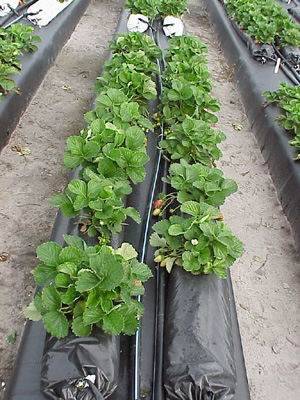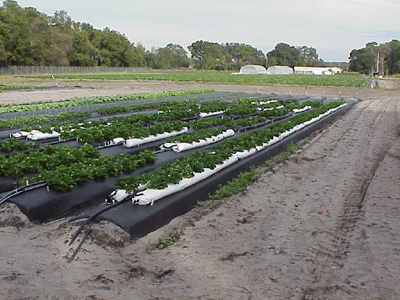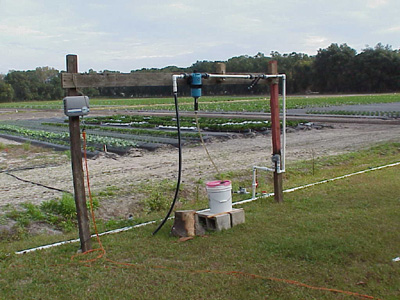UF/IFAS NEWS RELEASE
LIVE OAK---Faced with a 2005 ban on a widely used chemical that controls
soil pests, University of Florida researchers are working with growers
to develop new high-tech growing methods that eliminate the need for soil.
"Soilless agriculture is not the wave of the future, it's already here,"
said Bob Hochmuth, a vegetable expert with UF's Institute of Food and Agricultural
Sciences, who says the new growing methods have caught the attention of
growers around state -- especially for high-value crops such as tomatoes,
colored bell peppers, cucumbers, Bibb lettuce, herbs and strawberries.
"We're losing a valuable pesticide called methyl bromide because the
federal Environmental Protection Agency has found it contributes to the
destruction of the Earth's protective ozone layer in the atmosphere, so
it makes sense to move production of some high-value crops out of the soil
altogether," he said.
"In fact, some growers are desperately looking for alternatives to growing
crops outdoors in disease-infested fields, and they're turning to greenhouse
production and soilless growing mediums, commonly known as hydroponics,"
Hochmuth said. "All plant nutrients are supplied in the irrigation water."
He said most South Florida hydroponic production is in Collier, St.
Lucie and Palm Beach counties, and almost all North Florida hydroponic
production is in Suwannee County. Statewide, there are now more than 70
acres of crops under protective cover. Strawberry growers in Hillsborough
County also are looking at growing their crops outdoors in hydroponic systems.
The value of hydroponic crops produced in Florida totals about $14 million,
a mere fraction of the estimated $1.54 billion in regular field-grown vegetables.
Hochmuth, a multicounty extension agent based at UF's Suwannee Valley
Research and Education Center in Live Oak, said hydroponics is a more expensive
way to grow crops, but there are many advantages, especially on crops such
as tomatoes and strawberries.
"Growers can sell tomatoes for $2 to $3 per pound, and the cost of producing
greenhouse hydroponic vegetables ranges from $2 to $15 per square foot,"
he said. "But those higher costs can be offset by higher production --
up to 10 times higher than field-grown produce."
Hochmuth said longer marketing seasons are another big advantage for
greenhouse hydroponic crops. And, since they're not subjected to the usual
insect pests, weather conditions and other kinds of damage, greenhouse
crops have a better appearance for consumers and generally fetch higher
prices for growers.
He said the switch to hydroponics, which includes the use of inorganic
growing media such as perlite, makes it easier to avoid soilborne pests
and diseases that can affect the quality and appearance of high-value crops.
In tests at the UF's Gulf Coast Research and Education Center in Dover,
Hillsborough Extension Agent Eric Waldo and horticulturalist John Duval
are conducting a research and demonstration project to learn how well strawberries
grow outdoors in bags filled with perlite and other inorganic growing media.
"So far, the early results are encouraging, with higher yields from
plants in bags of perlite than from regular soil-grown plants," Waldo said.
"Essentially, what we're doing is growing strawberries in an outdoor
hydroponic system, supplying all the nutrients in irrigation water," Waldo
said. "The bags of perlite provide an inorganic growing medium for plant
roots, but the perlite has no nutrients or any of the harmful organisms
that typically infest regular soil."
While the cost of using perlite bags is higher than regular soil, growers
would not have the expense associated with methyl bromide soil fumigation
and herbicides for weed control.
With the coming ban on methyl bromide, Waldo said it will give strawberry
growers in the Plant City and Dover areas an alternative to growing their
crops in soils that are infested with nematodes and diseases.
Marvin Brown, president of BBI Produce Inc. in Dover, the state's largest
grower and shipper of fresh strawberries, said soilless strawberry production
-- although still in its infancy -- could be a part of his future.
"With the rapidly approaching deadline for discontinuing use of methyl
bromide as a soil fumigant and no viable replacement in sight, soilless
alternatives deserve serious attention," Brown said. "Advancements in technology
and growing techniques will undoubtedly increase our desire and ability
to use alternative production methods that are both economical and ecologically
acceptable to all."
For more information about the work of the University of Florida's IFAS (Institute of Food and Agricultural Sciences): go to IFAS Print News Releases
For more information about these and the many uses of perlite in hydroponic growing,
originally written by Chuck Woods
sources: Bob Hochmuth, Eric Waldo, and Marvin Brown
January 2000



contact your local extension service, The Perlite Institute (www.perlite.org)
The Schundler Company
10 Central Street
Nahant, MA 01908
(ph)732-287-2244 (fax) 732-287-4185
www.schundler.com
email: info@schundler.com
Back to Horticultural Main Page